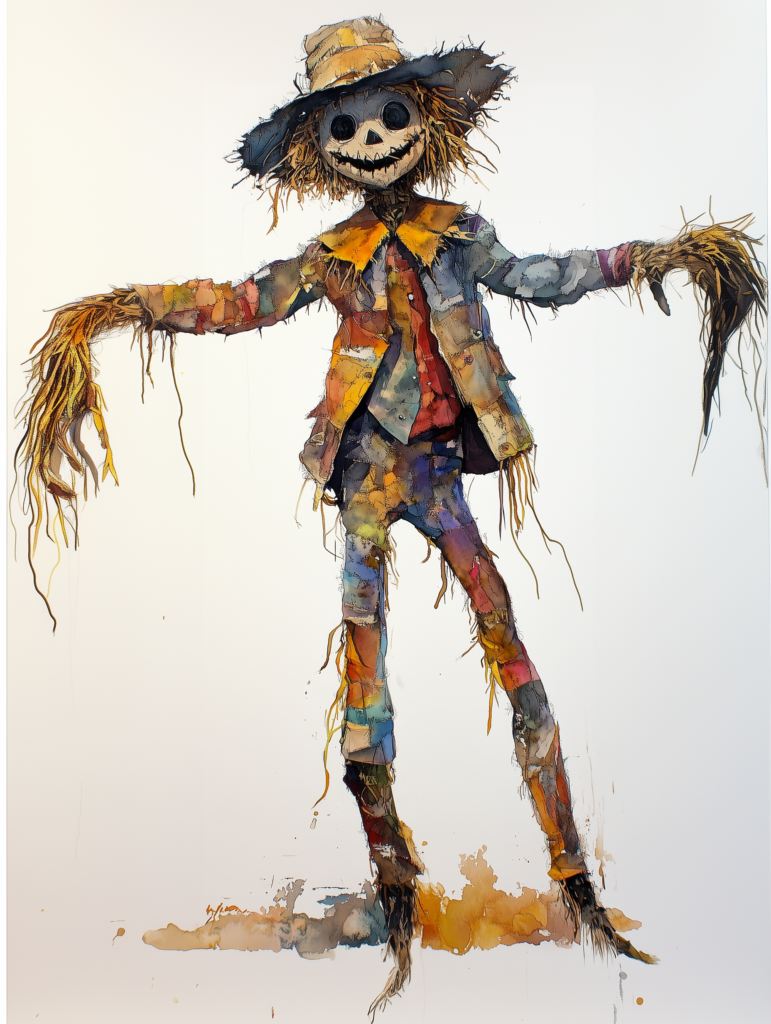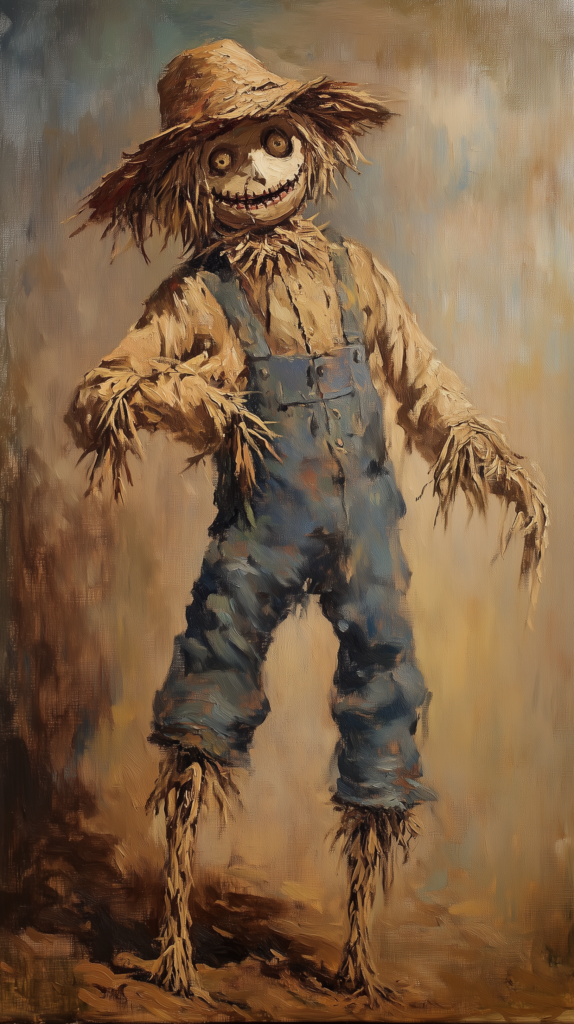The Scarecrow: The Hero Without a Brain
“Meet the Scarecrow: The brainless hero who outsmarts everyone on the Yellow Brick Road!”

- Alias – The Scarecrow
- Gender – Male
- Race – Animated Straw Figure (Construct)
- Occupation – Ruler of the Emerald City (Post-Wizard’s departure), Adventurer
- Religion – None (Not addressed in the story)
- Allies – Dorothy Gale, Tin Man, Cowardly Lion, Glinda the Good Witch, Wizard of Oz
- Enemies – Wicked Witch of the West, Kalidahs, Winkie Guards (formerly under the Witch’s control)
- Abode/ Base of operations – Initially the Cornfield (where he was created), later the Emerald City (as its ruler)
- Nationality – None (He is an animated being, not associated with a specific nation or origin)
- Languages – English (He communicates fluently with Dorothy and others)
- Alignment – Good (He is a loyal and selfless character)
- Affiliation(s) – Dorothy’s party (consisting of Dorothy, Tin Man, and Cowardly Lion), The Emerald City government (after becoming its ruler)
- Significant others – None mentioned explicitly in the story
The Scarecrow is one of the most iconic characters from L. Frank Baum’s The Wonderful Wizard of Oz. A figure initially perceived as lacking intelligence, he grows throughout the story to reveal wisdom, courage, and ingenuity. His central goal is to gain a brain, believing he is foolish without one, but his journey demonstrates that intelligence comes from within. Alongside Dorothy, the Tin Man, and the Cowardly Lion, the Scarecrow embarks on an adventure to the Emerald City, playing a pivotal role in overcoming challenges while seeking self-acceptance.
Life Story and Key Events
The Scarecrow’s story begins when Dorothy stumbles upon him in a cornfield. He is a figure made of straw, propped on a pole, and lamenting his lack of a brain. Though he is not physically restrained by his situation, the Scarecrow is psychologically stuck, believing he is limited by his stuffing. Dorothy helps him down, and he becomes her first and most faithful companion on the journey to the Emerald City.
Throughout the journey, the Scarecrow often proves his intelligence despite his self-perceived inadequacy. For example, when Dorothy and her companions face the Kalidahs—fierce creatures with the bodies of bears and the heads of tigers—the Scarecrow devises a plan to cut down a tree, creating a bridge to safety. Later, when they encounter a river too wide to cross, the Scarecrow suggests using a raft, demonstrating his quick thinking.
However, the Scarecrow’s most significant contribution comes from his role as a strategic thinker. While Dorothy and the others often hesitate, unsure of what to do, the Scarecrow frequently steps in with logical solutions. This becomes even more apparent when they confront the Wicked Witch of the West, where the Scarecrow uses resourcefulness to outwit the witch’s minions.
After many trials, the group finally reaches the Emerald City, where the Wizard agrees to grant the Scarecrow a brain. In a twist of irony, the brain the Wizard provides is not a magical organ but rather a symbolic gesture—a mixture of bran and pins placed in the Scarecrow’s head. This simple act boosts the Scarecrow’s confidence, but the true lesson is that he had the intelligence all along. He just needed to believe in himself
At the end of the story, the Wizard appoints the Scarecrow as the ruler of the Emerald City after the Wizard departs in his balloon. This marks the culmination of the Scarecrow’s journey from self-doubt to leadership, proving he had the qualities of wisdom and leadership from the start
Character Description
The Scarecrow is visually distinctive, a figure made of old clothes stuffed with straw, giving him a lanky, slightly awkward appearance. His face is cheerful and expressive, but his self-doubt is deeply rooted in his belief that his straw head cannot generate intelligent thoughts. He is brave, compassionate, and extremely loyal to Dorothy, always ready to help despite his fear of inadequacy.
His one great fear is fire, which could destroy his straw body and end his life. This fear symbolizes his vulnerability and his broader fear of being useless or disposable, something he grapples with on an emotional level throughout the story.
While his greatest desire is to gain a brain, what the Scarecrow truly seeks is validation and a sense of worth. Throughout his life, he has been led to believe that without a brain, he is of little value. However, his actions prove otherwise. His longing for intellect and rationality often blinds him to the fact that he is already the smartest of the group. His evolution from a self-conscious figure to a confident leader reflects his journey toward self-realization
Exploits and Achievements
The Scarecrow’s achievements are numerous. He saves his friends from multiple dangers, including the Kalidahs, the deadly poppy field, and the Wicked Witch’s various traps. His sharp mind and quick thinking help them reach their destination when others falter.
Perhaps his most significant achievement, however, is his personal growth. By the end of the story, the Scarecrow no longer doubts his intelligence, and his acceptance of his own value leads to his becoming the ruler of the Emerald City. This marks a full transformation from a creature of straw, who felt insignificant, to a respected leader who embodies wisdom and integrity.
Legacy
The Scarecrow’s journey in The Wizard of Oz resonates with readers as a powerful tale of self-discovery. Though he believed he needed external approval to feel intelligent, his story teaches that inner worth and intelligence are not defined by outward appearances or other people’s validation.
As a symbol, the Scarecrow represents the triumph of practicality over self-doubt and the realization that true intelligence often comes from experience and confidence, not from academic knowledge or external approval. His character continues to be celebrated in adaptations and analyses as one of the most lovable and inspirational figures in literature.
The Scarecrow (Legendary Creature)

Medium Construct (Humanoid), Lawful Good
Armor Class: 14 (natural armor, patchwork clothes)
Hit Points: 85 (10d8+40)
Speed: 30 ft.
| STR | DEX | CON | INT | WIS | CHA |
|---|---|---|---|---|---|
| 12 (+1) | 16 (+3) | 18 (+4) | 18 (+4) | 16 (+3) | 12 (+1) |
Saving Throws: DEX +6, INT +7, WIS +6
Skills: Investigation +7, Insight +6, Perception +6, Survival +6
Damage Vulnerabilities: Fire
Damage Resistances: Bludgeoning, Piercing
Condition Immunities: Poisoned, Frightened, Charmed, Exhaustion
Senses: Passive Perception 16
Languages: Common, Ozian (an ancient language of the Emerald City)
Challenge: 6 (2,300 XP)
Traits
Straw Body
The Scarecrow’s body is made of straw and fabric. He can’t be poisoned, charmed, or frightened. He also doesn’t require food, drink, air, or sleep.
Brain of Bran and Pins (Symbolic Intelligence)
The Scarecrow’s brain may be symbolic, but he possesses great insight and intelligence. He gains advantage on all Intelligence (Investigation) and Wisdom (Insight) checks. He cannot be affected by spells that would reduce his Intelligence score or cause confusion.
Innate Problem Solver
Whenever the Scarecrow or an ally within 30 feet makes an Intelligence-based skill check, the Scarecrow may use his reaction to grant that roll advantage once per round.
Fire Vulnerability
Whenever the Scarecrow takes fire damage, he has disadvantage on saving throws until the end of his next turn, as his straw body is extremely flammable.
Actions
Multiattack
He makes two attacks with his pitchfork or one attack with his improvised weapon (if available).
- Pitchfork. Melee Weapon Attack: +6 to hit, reach 5 ft., one target. Hit: 12 (2d8+3) piercing damage.
Equipment: A rustic pitchfork used for farming, representing his agricultural origins. - Improvised Weapon (Rusty Bucket/Stick). Melee Weapon Attack: +6 to hit, reach 5 ft., one target. Hit: 7 (1d8+3) bludgeoning damage.
Straw Toss (Recharge 5-6)
The Scarecrow grabs a handful of straw from his body and throws it in the air. All creatures in a 15-foot cone must succeed on a DC 15 Dexterity saving throw or be blinded for 1 minute as the straw blows into their eyes. A creature can use its action to rub its eyes and end the effect.
Scare Away (Limited Use)
As an action, the Scarecrow can wave his arms and shout, causing creatures within 30 feet to make a DC 15 Wisdom saving throw. On a failed save, creatures are frightened for 1 minute. The Scarecrow can use this once per short or long rest. This ability only affects creatures of CR 3 or lower, and those not immune to fear effects.
Reactions
Deflect Attack
When a creature the Scarecrow can see attacks a target other than him within 5 feet, he can use his reaction to impose disadvantage on the attack roll by leaping awkwardly in front of the blow.
Uncanny Reflexes
The Scarecrow can avoid danger through sheer agility and luck. He may use his reaction to halve the damage from one attack he can see, as long as it isn’t fire damage.
Legendary Actions
The Scarecrow can take 1 legendary action at the end of another creature’s turn. He regains the ability to take a legendary action at the start of his turn.
- Quick Thinking (Costs 1 Action): The Scarecrow can make an Investigation or Perception check, or he can grant an ally advantage on their next check or saving throw within 30 feet.
- Patch Up (Costs 1 Action): The Scarecrow pulls straw from his body to mend a tear. He heals himself for 10 hit points. He can only use this ability twice per day.
Lair Actions
If the Scarecrow resides in the Emerald City or a similarly safe environment, he can take lair actions while within the area. On initiative count 20 (losing initiative ties), the Scarecrow can take a lair action to cause one of the following effects:
- Call for Aid: Emerald City Guards (CR 1) arrive to assist the Scarecrow. Roll 1d4 to determine how many guards join the fight.
- Puzzle the Intruders: The Scarecrow creates a confusing mental puzzle in the minds of his enemies. All enemies within the lair must make a DC 16 Intelligence saving throw or be stunned until the end of their next turn as they try to solve the imaginary puzzle.
- Improvise Defense: The Scarecrow quickly jury-rigs a defensive barrier out of nearby materials. He gains half cover until the start of his next turn.
Equipment
- Pitchfork (Rustic): A long, crude farming tool that can be wielded as a simple weapon.
- Patchwork Clothes: The Scarecrow wears torn and patched-up clothing, offering light natural protection (included in AC).
- Bag of Bran and Pins (Symbolic Brain)**: A pouch filled with bran and small metal pins, symbolizing the brain granted by the Wizard of Oz. This grants him a +2 bonus to Intelligence-related checks and saving throws.
Magic Items
- Straw of Preservation (Wondrous Item): When the Scarecrow’s body is reduced to 0 hit points, the scattered straw reforms over 1d4 hours, as long as a majority of his body remains intact. Once used, this ability cannot be used again for 7 days.
- Emerald City Key: As ruler of the Emerald City, the Scarecrow holds a magical key that opens any door or gate within the city’s walls, granting him unfettered access.
Personality and Tactics
The Scarecrow is a clever and quick-thinking leader, despite his outward appearance of clumsiness. He often plays a support role in combat, aiding his allies with tactical advice and clever improvised solutions. He avoids direct confrontation unless absolutely necessary, relying on his problem-solving abilities to outwit enemies. His primary fears are fire and failure, but his bravery for the sake of his friends often overcomes these fears.

 Buy me a coffee
Buy me a coffee